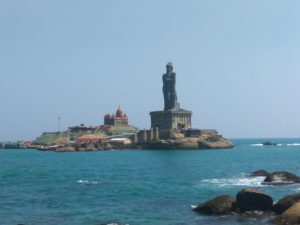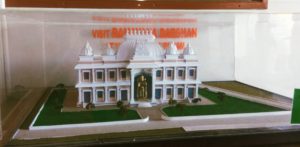Where is Kanyakumari?
Kanyakumari is the southernmost tip of the Indian peninsula. Beyond this point, only visible to eyes is endless water of the confluence of three oceans – Indian Ocean, Arabian sea & Bay of Bengal (Triveni Sangam).
Recently, we also got an opportunity to visit this beautiful place. After visiting this beautiful place, we realized what we would have missed having not been here.
We had been reading about this southernmost beauty in books and online, but had never thought how it would be in reality.
My Journey to Vivekanand Rock Memorial
Our itinerary comprised of a road trip from Trivandrum, Kerala to Kanyakumari, Tamilnadu, a stretch of 104 km. The entire journey was a panoramic eye treat with mesmerising scenic beauty, coconut harvesting lands and backwaters and curvy roads felt heavenly.
Three hours drive was full of beauty blast. The water is crystal clear with different hues of colour, standing amid of which is Swami Vivekanand rock memorial, one of the two rocks located 500m away from the mainland of Vavathurai, Kanyakumari. The memorial is a live example of human endeavour, commitment and perseverance.
One needs to avail ferry service from Kanyakumari to reach memorial. It took us almost two hours to us to fetch a ferry, fortunately, we got to stand in the line which would go straight to ferry (after spending a few extra bucks from the pocket!). But all well that ends well.
Glass enclosure depicting Ramayana in memorial premises.
The Vievkanand Rock Memorial at a Glance
Premises has two primary mandapam- Sripada Mandapam and Vivekananda Mandapam, facing each other.
Shripada Mandapam
It is a square hall with various sections namely Garbha Graham which is the Sanctum Sanctorum, Inner Prakaram, Outer Prakaram and Outer Platform around the hall. It is believed that it is the place where Goddess Kanya Kumari did her penance. Mandapam is named as Shri Pada Parai because of the small projection which resembles the human feet. This name is of Tamil origin denoting the rock which has been sanctified by the Goddess’s feet. The monument is a melange of Tamil Nadu and West Bengal style of architecture.
Swami Vivekananda Memorial Mandapam
It resembles Sri Ramakrishna Temple at Belur, West Bengal. Th design of its entrance features architectural styles of Ajanta and Ellora. The mandapam have been built in such a way that the statue of Swami Vivekananda can be seen directly from Sripadam.
History of Smami Vivekananda Rock Memorial
Smami Vivekanad Rock Memorial was completed in 1970, after six years of construction. Swami Ji arrived in Kanyakumari in 1892 and meditated on this rock for two days, before his departure for Chicago to attend World Religious Conference. It is believed that at this place, Goddess Parvati blessed Swami Ji.
Swami Vivekanand laid the foundation of Ramkrishan mission in 1897 following the path shown by his spiritual master, Ramakrishna Paramhansa. Swami lived a short but an inspirational life, he died at the age of 39 years only (1902), but he took the batten of Hinduism all over the world.
National Youth Day – 12 January
The entire span of one year for Swami Ji’s 100th birthday was proposed to be celebrated as the Centenary Year. Every year since 1985, the birth anniversary of Swami Ji is commemorated as National Youth Day (12 January).
Swami Ji believed, “Few heart-whole, sincere, and energetic men and women can do more in a year than a mob in a century“. During his sojourn in America, he gathered huge appreciation who venerated him as “a cyclonic monk from India”.
The mandapam has 6 adjacent rooms. 1) Dhyana Mandapam, Meditation Hall with six adjacent rooms (2) Sabha Mandapam or the Assembly Hall including Pratima Mandapam (statue section), two rooms, a corridor and an open Prakaram round the Sabha Mandapam (3) Mukha Mandapam (Portion) and (4) the Front Entrance steps with two rooms and a corridor below the steps.
‘Dhyana Mandapam’ or meditation hall displays a centre staged Screen. In the pitch black tranquillity of Mandapam, illuminating, reflecting and reverberating the sound of mystic mantra Aum, a blissful experience indeed!
Saint Thiruvalluvar Statue
Second rock is situated a few meters distance from main rock memorial, the ferry takes a halt here before proceeding towards Vivekanand mandapam and standing here is a colossal statue of Saint Thiruvalluvar, one of the pioneers Tamil poets and philosophers.
Architecture and sculpting of the statue have deep meaning. The statue is staged on a 38 feet high pedestal to symbolize 38 chapters of virtue in the Thirukkural. The total height of the statue and pedestal is 133 feet, also symbolic of the 133 chapters in Thirukkural.
Pedestal staging statue is three-tiered, called as Athara Peedam, surrounded by mandapam known as Alankara Mandapam, in turn, surrounded by 10 statues of elephants which symbolise 10 directions in which King Dasaratha, the father of Lord Rama, could chariot. Inside the mandapam, 140 steps have been constructed so that visitors can climb up to the pedestal, and reach the feet of the statue. On the outside edges of the pedestal, a few couplets from Thirukkural have been inscribed.
The statue is sculpted with a slight bend at the waist, signifies dancing pose of Nataraja, a form of Lord Shiva. The face of the statue is 19 feet high. All the features of the face including ears, forehead, eyes and mouth have been sculpted manually.
The right hand of Thiruvalluvar Statue is pointing to the sky with three fingers. This is symbolic of three stanzas of Thirukkural- Aṟam (dharma), Poruḷ (artha), and Inbam ( Anand).






